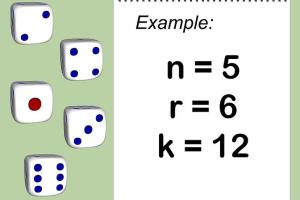Mastering Dice: A Comprehensive Guide to Calculating Multiple Dice Probabilities

-
Quick Links:
- Introduction
- Understanding Dice
- Basic Probability Concepts
- Calculating Single Die Probabilities
- Calculating Multiple Dice Probabilities
- Case Studies
- Step-by-Step Guide
- Expert Insights
- Real-World Applications
- Conclusion
- FAQs
Introduction
Dice games have been a staple of entertainment for centuries, spanning cultures and generations. However, what many players overlook is the underlying mathematics that governs the outcomes of these games. Understanding how to calculate probabilities, especially with multiple dice, can greatly enhance your gaming strategy. This article will delve into the mechanics of dice probability, providing a thorough understanding of how to calculate probabilities for single and multiple dice.
Understanding Dice
Dice are small, throwable objects that have six sides, each displaying a different number of dots from one to six. While the most common dice are the six-sided ones (often referred to as d6), there are many variations, including:
- Four-sided dice (d4)
- Eight-sided dice (d8)
- Twelve-sided dice (d12)
- Twenty-sided dice (d20)
Basic Probability Concepts
Probability is the measure of the likelihood of an event occurring. It is calculated using the formula:
Probability (P) = Number of favorable outcomes / Total number of outcomes
For example, when rolling a single six-sided die, the probability of rolling a 3 is:
P(rolling a 3) = 1 (favorable outcome) / 6 (total outcomes) = 1/6
Calculating Single Die Probabilities
To calculate the probability of a specific outcome on a single die, simply identify the number of favorable outcomes and divide it by the total number of possible outcomes. For example:
- P(rolling a 1) = 1/6
- P(rolling an even number) = 3/6 = 1/2
- P(rolling a number greater than 4) = 2/6 = 1/3
Calculating Multiple Dice Probabilities
When rolling two or more dice, the calculation becomes more complex. The total number of outcomes is determined by raising the number of sides on the die to the power of the number of dice being rolled. For example, when rolling two six-sided dice:
Total Outcomes = 6 (sides) ^ 2 (dice) = 36
To find the probability of rolling a specific sum (like 7), we must count how many combinations produce that sum:
- (1, 6)
- (2, 5)
- (3, 4)
- (4, 3)
- (5, 2)
- (6, 1)
Thus, P(rolling a sum of 7) = 6 (favorable outcomes) / 36 (total outcomes) = 1/6.
Case Studies
To illustrate these principles, let’s explore a couple of case studies involving multiple dice rolls and their implications in games.
Case Study 1: The Game of Craps
Craps is a popular casino dice game that heavily relies on understanding multiple dice probabilities. Players bet on the outcome of two six-sided dice rolled together. The probabilities of rolling certain sums dictate betting strategies. For instance, the chance of rolling a 7 is the highest, making it a favorable bet.
Case Study 2: Dungeons & Dragons
Dungeons & Dragons (D&D) uses various dice, such as d20s for attack rolls and d6s for damage. Understanding probabilities can help players make informed decisions about their actions in-game based on likely outcomes.
Step-by-Step Guide to Calculating Multiple Dice Probabilities
Here’s a detailed guide to help you calculate probabilities for multiple dice rolls:
Step 1: Identify the Dice Used
Determine the types and numbers of dice to be rolled (e.g., two d6s).
Step 2: Determine Total Outcomes
Calculate the total outcomes using the formula: Number of sides ^ Number of dice.
Step 3: Identify Favorable Outcomes
List all combinations that produce the desired outcome (sum or specific number).
Step 4: Calculate Probability
Use the probability formula to find the likelihood of desired outcomes.
Expert Insights
Experts in probability theory emphasize the importance of understanding these calculations not just for gaming but also for strategic decision-making in various fields. As you become more adept at calculating dice probabilities, you can apply this knowledge to areas like risk assessment, game design, and statistical analysis.
Real-World Applications
Beyond gaming, understanding multiple dice probabilities has applications in:
- Statistical modeling
- Risk management in finance
- Game development
- Teaching mathematics through interactive games
Conclusion
Mastering the calculation of multiple dice probabilities enriches your gaming experience and enhances your analytical skills. Whether you’re a casual gamer or looking to strategize for competitive play, understanding these concepts can provide you with a significant edge.
FAQs
- What is the probability of rolling a double in two six-sided dice?
The probability of rolling a double (e.g., (1,1), (2,2)) with two six-sided dice is 6/36 or 1/6. - How do I calculate the probability of rolling a sum of 10 with two dice?
The combinations that yield a sum of 10 are (4,6), (5,5), and (6,4); hence, the probability is 3/36 or 1/12. - What happens when I roll more than two dice?
The total outcomes increase exponentially, making calculations more complex, but the same principles apply. - Can I use this probability knowledge in board games?
Yes, many board games involve dice and understanding probabilities can improve your chances of winning. - Are there tools to help calculate dice probabilities?
Yes, there are several online calculators and resources available to assist with these calculations. - How does this relate to real-life decisions?
Understanding probabilities can aid in making informed decisions under uncertainty, applicable in finance and risk assessment. - Is calculating probabilities necessary for all dice games?
While not necessary, it certainly enhances strategy and enjoyment. - Do all dice follow the same probability rules?
No, different types of dice (e.g., d4, d8) have different total outcomes which affect probability calculations. - Can I apply these rules to non-dice games?
Absolutely! The principles of probability are universal and can be applied to various scenarios. - What is the most common sum rolled with two six-sided dice?
The most common sum is 7, which has the highest number of combinations (six).
Random Reads